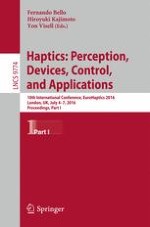2016 | OriginalPaper | Chapter
Individuals with Chronic Hemiparetic Stroke Correctly Match Forearm Position Within a Single Arm: Preliminary Findings
Authors : Erik J. Euving, Netta Gurari, Justin M. Drogos, Stuart Traxel, Arno H. A. Stienen, Julius P. A. Dewald
Published in: Haptics: Perception, Devices, Control, and Applications
Publisher: Springer International Publishing
Activate our intelligent search to find suitable subject content or patents.
Select sections of text to find matching patents with Artificial Intelligence. powered by
Select sections of text to find additional relevant content using AI-assisted search. powered by
